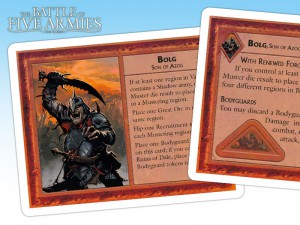In this last article, we’ll tell you about the development of the final two elements making Battle of the Five Armies unique from its predecessors included in Battles of the Third Age and we’ll set you up with the full PDF Rules.
The Goblins
An important strategic element in the battle's story is the two-pronged attacks of the goblin horde. Bolg did not simply count on numerical superiority to win – The Shadow host cunningly used the goblins' climbing ability to launch an assault through the mountain, attacking the Free People defenders from above, while the bulk of the army advanced into the Valley.
This strategy almost gave to the Shadow a decisive win, except for the timely arrival of the Eagles. So, we had to find a way to make it a part of the game, without making it too powerful or predictable.
The action dice mechanic is a great resource and perfect for this purpose. Limiting the availability of some actions to certain action die results make sure players cannot rely on the same sequence of events. In Battle of the Five Armies, we decided to link the “Eye” result of our standard WOTR dice to the presence and abilities of the Goblins. The Shadow player may use this result to attack, but he can also amass the Goblins in two special areas, called Mountain Passes.
When these areas are full, it means that the Goblins are ready to launch the assault, and the pass “opens” to allow them to move through and attack the defenders on the spurs of the mountain.
This unpredictable behavior leaves the defender in the dark about the best strategy. The Free Peoples player is always struggling - he does not have all the troops he needs to defend everywhere at once. Deciding what to do, when he sees those Goblins preparing to attack from above, is always tough. Should he fall back, allow them free movement, and counter-attack later? Should he defend the passes to the last man (or dwarf and elf) to prevent them from crushing through the Free People lines from behind?
Thanks to the action-dice mechanic, the pace at which Goblins muster creates a very different situation from one game to the next, enhancing the replay value of the Battle. Sometimes, the Goblins will be a decisive element in the battle; but in another game, they may not even show up and the host in the Valley will have more actions to use to drive the main assault up to the Front Gate. This leads to some very interesting dilemmas for the strategic plans of both players.
Bolg, Son of Azog
In the previous articles, we discussed the Free Peoples characters at some length. The Shadow player does not have the luxury of so many prominent individuals in his army (on the other hand, he has plenty of troops…). However, the one character available to him – Bolg, Son of Azog – is of fundamental importance.
It is clear, from what we read in “The Hobbit,” Bolg is no ordinary Orc. He gathers one of the most impressive armies in Middle-earth, he strikes fast, he develops a cunning battle-plan, and, in the end, his downfall at the hands of Beorn throws the Shadow army in dismay.
Not only that, he is clearly a formidable opponent, thanks to his own strength and his powerful bodyguard – the attack of Thorin and his companions, with the aid of the best of the Free Peoples army, cannot “pierce their ranks,” says the story.
Once again, designing such a powerful character is not an easy challenge. The goals to achieve were clear: Bolg must be a powerful presence in the battle, and Beorn must be a matched opponent for him and his bodyguard. At the same time, you do not want these results taken for granted – this is partly achieved by the variable strength of Beorn, as we wrote in our article about Fate. This also partly depends on the play of some Event cards, which can make Bolg’s bodyguard even stronger than normal.
Bolg’s bodyguard allows Bolg - and the army with him - to withstand an impressive amount of damage while remaining at full combat strength. The Free Peoples cannot ever easily win a battle against Bolg – but if they do not even try, and weaken him with repeated assaults, even Beorn might not be strong enough to take him down.
There’s a limit to Bolg’s power, however – his importance to the Shadow player also means he cannot be thrown recklessly into battle after battle. If Bolg is eliminated, the Free Peoples player wins an immediate victory. The most powerful weapon in the arsenal of the Shadow player may also be his downfall, if it is lost…
The Road Goes Ever On
In the seven articles of these Designer’s Notes we discussed at length many of the design choices behind the game. We could ramble on for a while – it’s not easy to sum up months of work, the playtests, the subtle and not-so-subtle changes, the turnarounds - but it’s finally time to lift the veil, download the rules, and find out for yourself how the game plays. Decide for yourself if it is indeed the game we wanted it to be: faithful to the story, but also highly replayable; strategically deep, but fast playing, and most important of all, fun to play!
We also hope The Battle of the Five Armies is the herald of great things to come for the War of the Ring game line. This is the first time we have published a new, stand-alone game based on War of the Ring, and its success may bring very interesting developments in the near future…
And now, enough with previews and spoilers! It’s finally time to read and learn the full rules of The Battle of the Five Armies.











